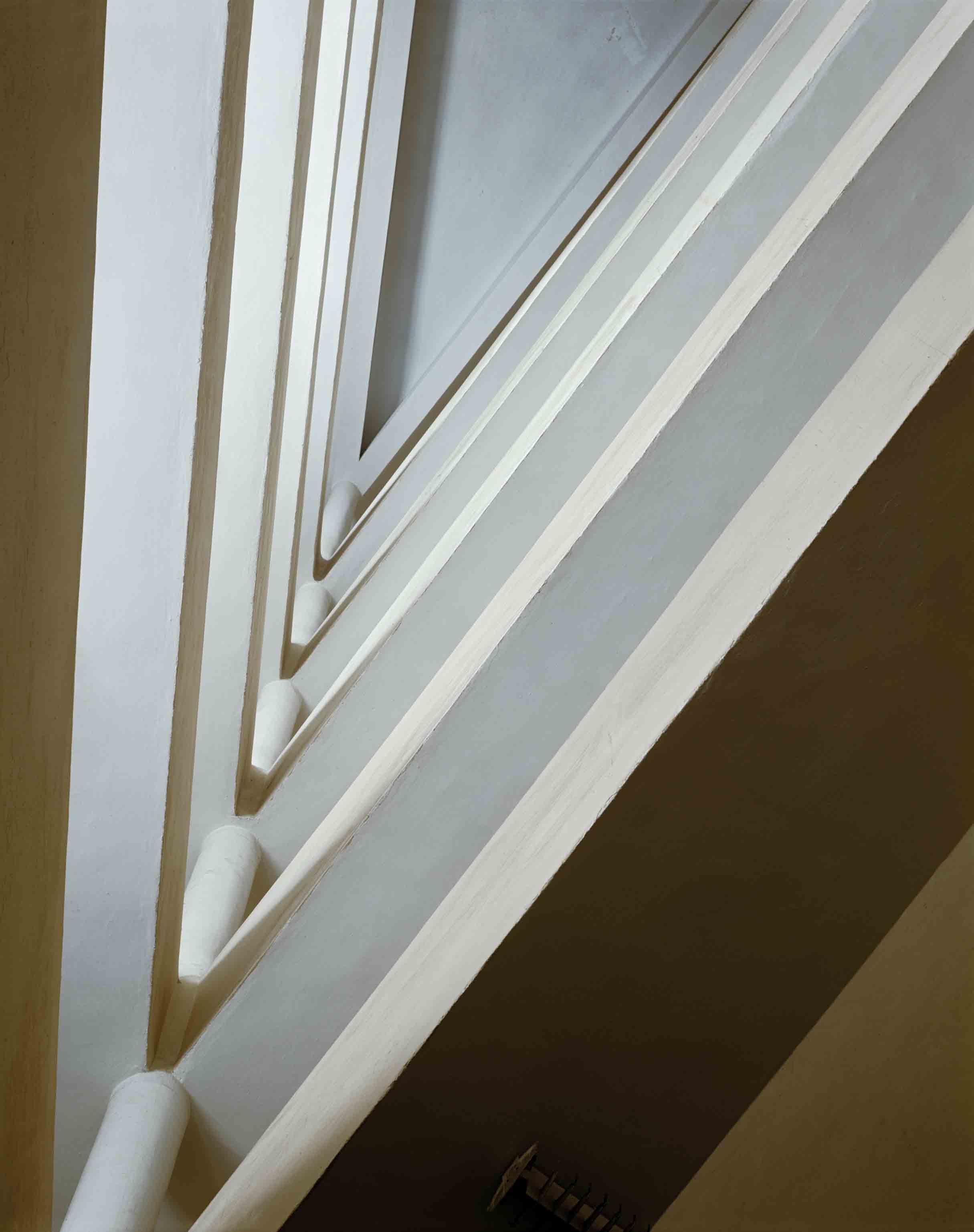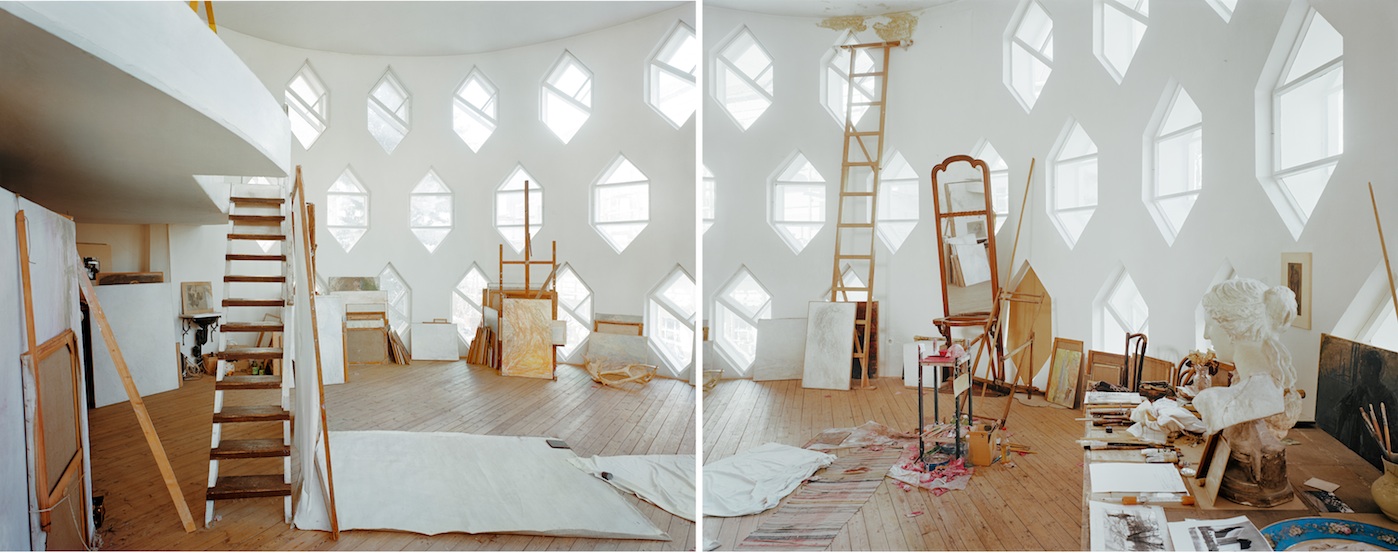The Lost Vanguard: Soviet Modernist Architecture, 1922-32
Graham Foundation, Chicago, October 11, 2012-February 16, 2013
The Lost Vanguard: Soviet Modernist Architecture, 1922-32 presents a small selection of British photographer Richard Pare’s massive archive of nearly 15,000 photographs of modernist Soviet architecture in Russia, Ukraine, Georgia, and Azerbaijan. The exhibition, on view at the Graham Foundation’s prairie-style Madlener House, was part of an original exhibition produced by the Museum of Modern Art in New York. Framing the project as a documentary enterprise, The Lost Vanguard posits that the sites captured by Pare were largely unknown, not only in the West but also within the Soviet Union, during the long period of neglect and inaccessibility in its later, closed years. Pare’s post-Soviet photographic project began in 1992 and continued for 15 years, offering one of the first opportunities to catch brief glimpses of these “lost” modernist edifices. His photographs reveal structures imbued with a new life and use in post-Soviet space, but just as often, crumbling and abandoned, and under threat of demolition.
The largest portion of the exhibition is housed on the first floor of the Madlener House and features the modernist architecture of Moscow, while the second floor features sites in Leningrad (now St. Petersburg), smaller Russian cities, Ukraine, and Azerbaijan. The easily overshadowed placards that accompany Pare’s large-format chromogenic color prints include a small photographic image of the building taken at time of completion as well as detailed information about its design, the architect, and the original function of the building. The exhibition features well-known Russian architects, such as Konstantin Melnikov and Moisei Ginzburg, in addition to the likes of Le Corbusier and Erich Mendelsohn, forging a direct link between the U.S.S.R. and Western European modernist design before it became increasingly closed to foreign influence and collaboration in the late 1930s. While in some instances it is possible to deduce the sites of the documented buildings, their exact locations are not disclosed. As such, the structures lack a real sense of integration into their settings, be it Moscow or Kharkov. The effect is one of isolation; the viewer is presented with discrete expressions of a certain architectural form, now the sites of near ruin.
 Direct influence of the vanguard style is apparent in several of Pare’s photographs. Images of unembellished straight lines, spirals and right angles revel in the recognizable language of modernist architecture, and reflect the modernist lines and inspiration of the buildings themselves. Arguably the most iconic image of the exhibition, the Shabolovka Radio Tower (Vladimir Shukhov, 1922), seems to directly quote Tatlin’s Monument to the Third International with the distinct, disorienting upward angle of the photographer’s lens.
Direct influence of the vanguard style is apparent in several of Pare’s photographs. Images of unembellished straight lines, spirals and right angles revel in the recognizable language of modernist architecture, and reflect the modernist lines and inspiration of the buildings themselves. Arguably the most iconic image of the exhibition, the Shabolovka Radio Tower (Vladimir Shukhov, 1922), seems to directly quote Tatlin’s Monument to the Third International with the distinct, disorienting upward angle of the photographer’s lens.
 More unexpectedly poignant are Pare’s images of the mundane views of his architectural subjects and their interiors. The most successful of these photographs create intriguing subnarratives intertwining the past and present, interiors and exteriors, of the modernist spaces. While the original photograph accompanying the Constructivist Narkomfin Communal House (Mosei Ginzburg and Ignati Milinis, 1930) from 1931 enhances the dynamism of the building’s innovative construction and utopian idealism, Pare’s photo stares straight onto its façade at street level, while bare tree branches break into the frame, foregrounding the passage of time. The large image of the interior of an apartment texturally and thematically draws the viewer in further. The striking blue, a color that appears most often throughout the exhibition as the bright color of the Russian sky against the gray of crumbling modernist edifices, is the oversaturated and peeling texture of the apartment wall. The pieces of byt (everyday life) scattered across a small dining table further clutter the space. Here the clean lines of the avant-garde are buried and muddled beneath the everyday needs of human inhabitants and the neglect of time.
More unexpectedly poignant are Pare’s images of the mundane views of his architectural subjects and their interiors. The most successful of these photographs create intriguing subnarratives intertwining the past and present, interiors and exteriors, of the modernist spaces. While the original photograph accompanying the Constructivist Narkomfin Communal House (Mosei Ginzburg and Ignati Milinis, 1930) from 1931 enhances the dynamism of the building’s innovative construction and utopian idealism, Pare’s photo stares straight onto its façade at street level, while bare tree branches break into the frame, foregrounding the passage of time. The large image of the interior of an apartment texturally and thematically draws the viewer in further. The striking blue, a color that appears most often throughout the exhibition as the bright color of the Russian sky against the gray of crumbling modernist edifices, is the oversaturated and peeling texture of the apartment wall. The pieces of byt (everyday life) scattered across a small dining table further clutter the space. Here the clean lines of the avant-garde are buried and muddled beneath the everyday needs of human inhabitants and the neglect of time.
 The same might be said of Pare’s images of abandoned factory interiors, including the Red Banner Textile Factory in Leningrad (Erich Mendelsohn, 1925-1937). In contrast to his image of the expressionist exterior of the building, here recreating the photograph taken around the time of the building’s completion, Pare also captures an indistinct confusion of abandoned machinery, which is reduced simply to textures in the plane of his photograph. In the face of the oversized chromogenic print, the viewer, perhaps rather like Pare, is left searching for traces of habitation in order to piece together the building’s past and its threatened future.
The same might be said of Pare’s images of abandoned factory interiors, including the Red Banner Textile Factory in Leningrad (Erich Mendelsohn, 1925-1937). In contrast to his image of the expressionist exterior of the building, here recreating the photograph taken around the time of the building’s completion, Pare also captures an indistinct confusion of abandoned machinery, which is reduced simply to textures in the plane of his photograph. In the face of the oversized chromogenic print, the viewer, perhaps rather like Pare, is left searching for traces of habitation in order to piece together the building’s past and its threatened future.
Pare’s series of photographs of the intriguing Melnikov House (Konstantin Melnikov, 1927-1931) capture a more distinctly personal narrative. The cylindrical house designed by and for the architect in central Moscow is presented from several vantage points, including the house’s exterior and interior, telling a multi-faceted story from the outside in. While Melnikov experienced great success in the mid-1920s, he, along with the experimental architecture of the period, had fallen out of favor by the late 1930s, wherein this modern marvel became a gloomy and isolating refuge. The careful arrangement of Pare’s images follows this rise and fall, capturing the interior studio in bright light streaming through the signature hexagonal windows, creating a sense that this space is poised for the arrival of the architect or designer. However, a final image provides a smaller-format glimpse of the dark isolation of the same interior space through a framing of the dark stairway and seemingly abandoned objects.
 The smallest room, located on the third floor of the Madlender House, features Pare’s images of Lenin’s Mausoleum (Aleksei Shchusev, 1924) and offers a departure from the theme of the “lost vanguard.” While the construction of the monument, beginning in 1924, situates the structure chronologically within the “vanguard” spread of the exhibition, the placement of these photographs, as well as their subject matter, give the impression that this is both a culmination of the modernist experiment and a marker of its end. The building itself, like Shchusev the architect, embodies both modernist design and points to a shift to a Soviet classicist style. However, as in so many of his photographs, Pare’s attention to texture makes these images both palpable and arresting. The red and black marble of the mausoleum creates a smooth reflective surface not encountered anywhere else in this exhibition of fallen and decaying buildings. Unlike the other examples of the lost vanguard, this monument is ossified in both form and function; while undergoing subtle remodeling and renovation in its long history, it has always served as the resting place of the Soviet leader (its long-term inhabitant), remaining an enduring symbol of this first epoch of Soviet history. And while the mausoleum is neither lost nor neglected, but rather situated on Red Square, it occupies a central place in both Soviet and non-Soviet space. The subtle inclusion of Lenin’s figure (his hand, the outline of his head) creates a particularly eerie effect that forges a link with the images of abandonment and death elsewhere in the exhibition.
The smallest room, located on the third floor of the Madlender House, features Pare’s images of Lenin’s Mausoleum (Aleksei Shchusev, 1924) and offers a departure from the theme of the “lost vanguard.” While the construction of the monument, beginning in 1924, situates the structure chronologically within the “vanguard” spread of the exhibition, the placement of these photographs, as well as their subject matter, give the impression that this is both a culmination of the modernist experiment and a marker of its end. The building itself, like Shchusev the architect, embodies both modernist design and points to a shift to a Soviet classicist style. However, as in so many of his photographs, Pare’s attention to texture makes these images both palpable and arresting. The red and black marble of the mausoleum creates a smooth reflective surface not encountered anywhere else in this exhibition of fallen and decaying buildings. Unlike the other examples of the lost vanguard, this monument is ossified in both form and function; while undergoing subtle remodeling and renovation in its long history, it has always served as the resting place of the Soviet leader (its long-term inhabitant), remaining an enduring symbol of this first epoch of Soviet history. And while the mausoleum is neither lost nor neglected, but rather situated on Red Square, it occupies a central place in both Soviet and non-Soviet space. The subtle inclusion of Lenin’s figure (his hand, the outline of his head) creates a particularly eerie effect that forges a link with the images of abandonment and death elsewhere in the exhibition.
In today’s rapidly changing post-Soviet environment, in which the old is being quickly subsumed to make way for new, glittering capitalist enterprise, Pare’s documentary undertaking is an essential one. Pare is not alone in recognizing the necessity of such a project, assumed subsequently by photographers such as Frederic Chaubin in his book Cosmic Communist Constructions Photographed (2011). The Lost Vanguard presents a complex time capsule comprised of not only lost modernist architectural marvels, but also glimpses of a swiftly passing moment in contemporary post-Soviet space, which threatens to swallow the visible layers of a Soviet past.
A larger selection of Pare’s images is also featured in the exhibition’s richly detailed companion book, Lost Vanguard: Russian Modernist Architecture, 1922-1932 (The Monacelli Press, 2007).



